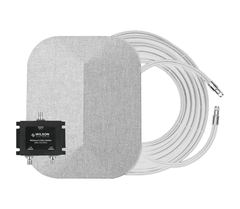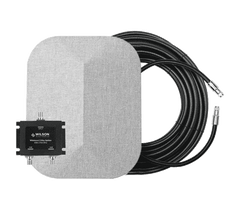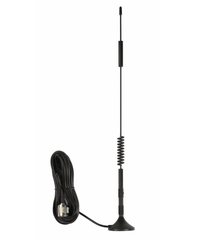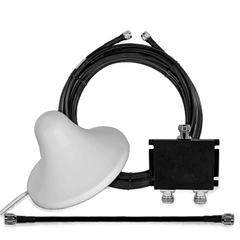An item you're pre-ordering is on backorder so it will take few days to ship - are you sure you want to proceed to order it?
CloseLow-PIM Dome Ceiling Antenna (50 Ohm) for Cell 3G, 4G, LTE, WiFi, DAS
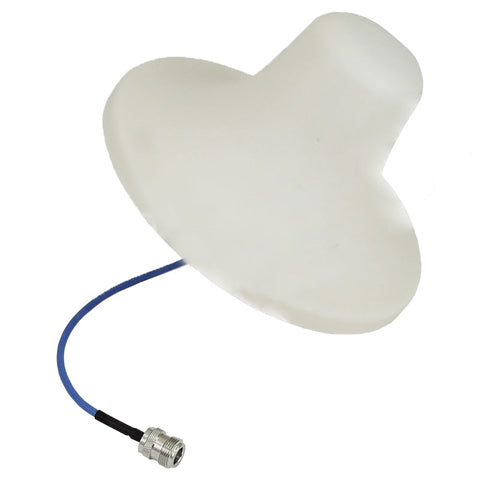
Low-PIM Dome Ceiling Antenna (50 Ohm) for Cell 3G, 4G, LTE, WiFi, DAS
Buy Now, Pay Later with No Interest if paid in full within 6-12 months. Choose Klarna payment option at the checkout for details of this, and other long-term low-interest financing options.
Free Lifetime Support. SKU / Model: AFC-AC0727G03NFS9
1(855)846-2654
Need installation quote, or help with designing a custom solution? Submit a request for quote.
- Description
- Reviews
- Questions & Answers
- Make An Offer
- Warning
Description
Product Description
Premium quality Low PIM Dome Ceiling Antenna (50 Ohm) is ideal for use not only with cellular boosters, but also with in-building wireless DAS networks used to distribute Cellular and WiFi signals through an area or building. This is our premium signal booster custom style # 9 inventory item: Low-PIM Dome Ceiling Antenna (50 Ohm) for Cell 3G, 4G, LTE, WiFi, DAS with UPC 697691010380.
This High Performance Ceiling Antenna is omnidirectional and provides wide coverage and high gain. The downward radiation pattern has been optimized for both WiFi and cellular signals. All 2G, 3G, 4G and LTE cellular bands, as well as the 2.4 GHz WiFi band are covered. This makes the antenna ideal for use not only with cellular boosters, but also with in-building wireless DAS networks used to distribute Cellular and WiFi signals through an area or building.
This discreet, attractive white dome blends in with home ceilings and commercial office environments. As it mounts directly via a small hole in a drop ceiling tile, no backing plate is required. It can however also be attached to fixed ceilings or other structures with an optional bracket. The antenna can be used outdoors, providing it is mounted in a dry location.
Low PIM antenna is compatible with any 50 Ohm cellular booster, including Hiboost, Wilson Electronics, weBoost, and Surecall. An N-Female connector is used to terminate the antenna lead.
For increased coverage, many units can be connected using a directional coupler or signal splitter. All antennas are fully tested before shipment.
Features.
- Compatible with all 50 Ohm Boosters.
- Cellular 2G, 3G, 4G and LTE Band Coverage.
- Compact.
- Discreet Design.
- Mounts to Ceiling Tile Easily.
- No Backing Plate needed.
- Broad Omnidirectional Coverage.
- 50 Ohm N Female Connector.
- Low-PIM Design Reduces Signal Interference.
Applications.
- IEEE 802.11b/g/n WiFi, WiMAX.
- Distributed Antenna Systems (DAS).
- 800 MHz Cellular / PCS.
- Covered outdoor areas (ODAS).
- In-building Wireless 2G, 3G, 4G and LTE Cellular Boosters.
- AWS-3, UMTS, DCS and GSM.
- Wilson weBoost, Surecall, Uniden Boosters.
Specifications:
| Frequency Range | 698 to 960 / 1710 to 2700 MHz |
|---|---|
| Bandwidth | 262 MHz / 990 MHz |
| Gain | 2.5±0.5 dBi @ 698 to 960 MHz and 4.5±0.53 dBi @ 1710 to 2700 MHz (Typical) |
| Polarization | Vertical |
| Horizontal Beamwidth | 360 Degrees |
| Vertical Beamwidth | 60 / 35 Degrees |
| PIM 2 x 2 W | ≤-153 dBc |
| VSWR | ≤1.8:1 / ≤1.5:1 |
| Impedance | 50 Ohm |
| Cable length | 12 Inches (305 mm) |
| Connector Type | Type N Female |
| Maximum Power | 100 Watts |
| Dimensions | 8.0 x 4.5 Inches (204 x 113 mm) |
| Radome Material | White ABS |
| Temperature Range | -40°F to 140°F (-40°C to 60°C) |
| Weight | 0.88 Lbs. (0.4Kg) |
| Lightning Protection | DC Short |
What does Low-PIM Antenna Mean?
To understand what Low PIM antennas mean, we must first understand what is PIM or Passive Intermodulation.
What is PIM and What Causes It?
PIM stands for Passive Intermodulation. In wireless infrastructure, PIM is measured in dB's and typically occurs when two or more signals are present in a passive, non-linear element or device, such as a DAS solution. PIM occurs when signals mix together in elements typically expected to operate in a linear manner, thus generating unwanted signals related to the original signals.
PIM has become a growing concern for cellular network operators, with problems occurring due to the ageing of existing equipment, when installing new equipment, or when co-locating new carriers. It’s of particular concern when duplexing new carriers into old antenna runs.
This intermodulation distortion occurs in components typically described as linear, such as antennas, connectors, and cables. However, these devices are capable of generating intermodulation signals at -80 dBm and even higher when exposed to high RF powers found in cellular systems.
For cellular operators trying to maximize the reliability, capacity, and data rate of their network, not to mention their return on investment, PIM is a very serious issue.
As the industry decides on the new "standard" RF connector, let us look at the difference between low PIM and high PIM.
- Low PIM means happy customers and improved revenues for carriers, because users receive strong signals with more bandwidth.
- High PIM means lost customers for the carrier, because the end-user receives limited bandwidth and poor cellular reception.
What Does This Mean?
It means that, from a hardware point-of-view, the design intention of every connection must be to minimize PIM and all connections must be tested to ensure correct installation. PIM testing is all-important to both design and installation processes to ensure top performance from the system. With today’s high-speed digital data communications, PIM testing has become critical. Because high transmitter power creates PIM, on-site testing should be carried out either at, or above, regular transmitter power levels to ensure PIM issues will be revealed.
Reviews
Questions & Answers
QUESTIONS & ANSWERS
Have a Question?
Be the first to ask a question about this.
Data Sheet / User Guide
Make An Offer
Warning
Note: For any signal booster to help, outside signal strength must be at least -110 dB or there must be a clear line of sight to a cell tower that is within twenty miles. Before ordering, please check outside signal level in decibels or ensure that you can make and hold a phone call at any good spot outside where you can mount an exterior antenna. Square footage stated in signal booster listings is based on good signal outside. If it is any weaker, the boosted sq. ft. area will be considerably lower, accordingly.
Kevin K. of Anderson, California gave the following review:
Website is easy to use with plain straight forward info but could have had more on testing signal strength to make sure you get a strong enough booster.
Therefore, please note that stated sq. ft. coverage is based on good signal outside. For best results: If outside signal is weak, we suggest choosing the next higher sq. ft. coverage kit. If outside signal is very weak, we suggest choosing the kit with even more higher sq. ft. range bracket. Basically, higher the sq. ft. bracket, the more powerful the signal amplifier with greater Gain as well as higher uplink and downlink output power.
If outside signal is too weak (weaker than -110 dB), submit request for cell coverage solution assessment. Upon receipt of questionnaire, we will perform residential or business site survey. This will help us determine the system that is needed to improve cell coverage. Then, we will create system design using that system such as femtocell, active or hybrid distributed antenna system (DAS), or other carrier feed signal enhancing method available that will work at your signal-challenged location. Finally, we will schedule for installation after equipment and installation service quote has been approved by you, or your company.
For non installation-included kits: Most home / office / building cell signal booster kits only include bracket to mount exterior antenna on outside wall, edge of roof, or existing pipe up to 2 inches in diameter. Mounting pole not included with most kits, unless stated specifically that it is included for free. Therefore, a mounting post must be purchased separately if you will require it to mount exterior antenna.

Related Products




